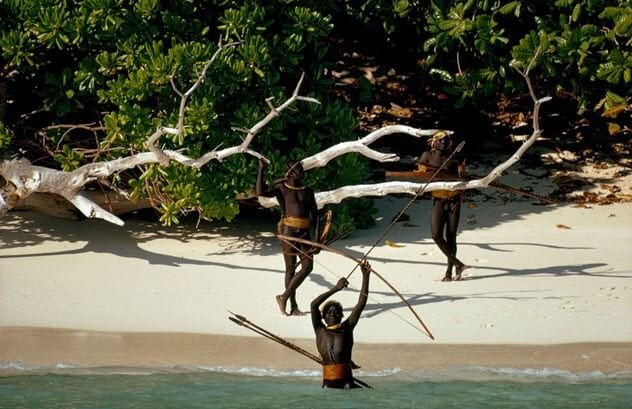Some History and Some Mystery: 6 Uncontacted Tribes of the World

Bhoomee Vats
When everyone hears the word “uncontacted,” they imagine people who are backward or uneducated, but in reality, these tribes are just trying to protect their culture and land by stopping the invasion of people from the outside world. In modern times, where even space is being explored, it is hard to imagine that any place is out of our reach, but these tribes and their lands are still disconnected from the entirety of the world. This disconnection makes it difficult for us to figure out how these tribes live, their lifestyle, what they eat, and what they wear. But their living in isolation does not make these tribes lost or confused; they are just living on their terms and conditions.
These tribes are not unaware of the outside world; at many times, they have seen glimpses of it, be it some technology flying over their heads or a stranger trying to invade their land. But contact with the outer world for them is not something they are curious about; it can only bring them danger and threats. Historically, these threats and dangers take the form of disease, violence, destruction of their culture and heritage, and even the loss of their land. Their isolation is not something out of coincidence, but it is a form of survival for them and a way to keep their unique heritage alive. The following are some of these tribes:
- Massaco– The Massaco are an uncontacted Indigenous tribe that resides in the Amazon rainforest, specifically within the Massaco Indigenous Territory in Rondônia, Brazil. They are famous for being disconnected from the world by avoiding contact with outsiders and fiercely protecting their territory with strategically placed, camouflaged, and sharp wooden spikes. The Massaco are skilled hunters, using longbows which are nearly three meters long, and are believed to be nomadic, i.e., they move their villages seasonally. The Massaco live within a 421,895-hectare (1.04 million acre) territory in the Amazonian state of Rondônia, near the border with Bolivia. They are one of the 28 known uncontacted tribes in the Amazon and choose to remain isolated from the modern world.
- Sentinelese– The Sentinelese is another indigenous tribe residing on North Sentinel Island in the Andaman Islands, which is in India. They are known for being isolated and hostile towards outsiders, making them one of the last uncontacted tribes in the world. The Indian government uses a “hands-off” approach to protect the way of life of this tribe and has also established a buffer zone around the island to prevent unwanted contact. The Sentinelese have had little to no contact with the outside world, which makes them highly vulnerable to diseases that are common everywhere else in the world. Their population is unknown, but estimates range from a few dozen to a few hundred.
- Kawahiva- The Kawahiva is an isolated indigenous tribe living in the Brazilian Amazon, specifically near the Rio Pardo in Mato Grosso. They are nomadic hunter-gatherers and are known for their isolation and limited contact with outsiders. The Kawahiva are facing several threats today, which range from logging, ranching, and disease due to attempted invasions into their territory. The Kawahiva live in the area of the “Arc of Deforestation” in the Brazilian Amazon, a region that is experiencing significant deforestation. They are nomadic hunter-gatherers, and hence are moving through the forest by building temporary shelters called “tapiris.”
- Matsigenka- The Matsigenka are an indigenous people residing in the rainforests of southeastern Peru, specifically the Urubamba, upper Madre de Dios, and Manu River basins. They are known for maintaining a close relationship with the natural world and their unique cultural traditions, which are deeply connected to their environment. Matsigenka is also the name of the language which they use and which belongs to the Arawakan language family. Their population is estimated to be around 12,000.
- Yaifo- The Yaifo people are yet another remote tribe in the East Sepik Province of Papua New Guinea in the highlands.The tribe was described by British writer, broadcaster, and explorer, Benedict Allen, in his account of a 1988 expedition, The Proving Grounds: A Journey through the Interior of New Guinea and Australia (1991). The tribe is visited very rarely and is among the remotest people in Papua New Guinea. They are one of the few tribes of people on earth who do not maintain contact with the outside world.The village of Yaipo in East Sepik Province is listed as speaking a dialect of the Nete language. In his encounter with the tribe for the first time 30 years ago, Benedict Allen wrote that he got to witness “a terrifying show of strength” and an energetic dance in which they displayed their bows and arrows.
- Togutil- Also known as O’Hongana Manyawa, and Inner Tobelo, is an indigenous group with a semi-nomadic lifestyle living in the jungles of Totodoku, Tukur-Tukur, Lolobata, Kobekulo, and Buli in the Aketajawe-Lolobata National Park, North Halmahera Regency, North Maluku, Indonesia. Their communities are often known as uncontacted people living in the inner jungle area. Their physical appearances, especially their facial features and skin tone, have a stronger resemblance to the Malay people than to the Tobelo people. Their settlements are usually found to be in groups of communities along river banks. There are about 42 households of Togutil communities that settled along the Dodaga river, while about 500 lived along the Akelamo river.
Conclusion
These six uncontacted tribes are just a few examples of many more that exist. They are not forced to stay isolated from the world; it is their own choice, and this choice shows a strong will and desire to protect their own culture and heritage from being destroyed or disrespected. Some people forget to respect these tribes and decide to invade them, forgetting how harmful this act can be for the tribal people and their lives. These invasions put them at the risk of being exposed to diseases they have not yet come across, which can even cost them their life and whole existence. It is important to protect these tribes and to preserve their cultural practices by leaving them be and not trying to disturb them.


